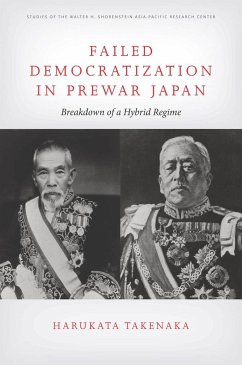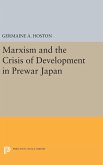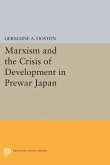- Gebundenes Buch
- Merkliste
- Auf die Merkliste
- Bewerten Bewerten
- Teilen
- Produkt teilen
- Produkterinnerung
- Produkterinnerung
Failed Democratization in Prewar Japan presents a compelling case study on change in political regimes through its exploration of Japan's transition to democracy. Within a broad-ranging examination of Japan's "semi-democratic" political system from 1918 to 1932, when political parties tended to dominate the government, the book analyzes in detail why this system collapsed in 1932 and discusses the implications of the failure. By reference to comparable cases-prewar Argentina, prewar Germany, postwar Brazil, and 1980s Thailand-Harukata Takenaka reveals that the factors responsible for the…mehr
Andere Kunden interessierten sich auch für
![Failed States Failed States]() Noam ChomskyFailed States48,99 €
Noam ChomskyFailed States48,99 €![Marxism and the Crisis of Development in Prewar Japan Marxism and the Crisis of Development in Prewar Japan]() Germaine A. HostonMarxism and the Crisis of Development in Prewar Japan136,99 €
Germaine A. HostonMarxism and the Crisis of Development in Prewar Japan136,99 €![Marxism and the Crisis of Development in Prewar Japan Marxism and the Crisis of Development in Prewar Japan]() Germaine A. HostonMarxism and the Crisis of Development in Prewar Japan51,99 €
Germaine A. HostonMarxism and the Crisis of Development in Prewar Japan51,99 €![Failed States Failed States]() Noam ChomskyFailed States19,99 €
Noam ChomskyFailed States19,99 €![Turning Point: Picking Up the Pieces After Eight Years of Failed Progressive Policies Turning Point: Picking Up the Pieces After Eight Years of Failed Progressive Policies]() Bob EhrlichTurning Point: Picking Up the Pieces After Eight Years of Failed Progressive Policies22,99 €
Bob EhrlichTurning Point: Picking Up the Pieces After Eight Years of Failed Progressive Policies22,99 €![Why the European Union Failed in Afghanistan Why the European Union Failed in Afghanistan]() Oz HassanWhy the European Union Failed in Afghanistan132,99 €
Oz HassanWhy the European Union Failed in Afghanistan132,99 €![The Failed Experiment The Failed Experiment]() Mart GramsThe Failed Experiment36,99 €
Mart GramsThe Failed Experiment36,99 €-
-
-
Failed Democratization in Prewar Japan presents a compelling case study on change in political regimes through its exploration of Japan's transition to democracy. Within a broad-ranging examination of Japan's "semi-democratic" political system from 1918 to 1932, when political parties tended to dominate the government, the book analyzes in detail why this system collapsed in 1932 and discusses the implications of the failure. By reference to comparable cases-prewar Argentina, prewar Germany, postwar Brazil, and 1980s Thailand-Harukata Takenaka reveals that the factors responsible for the breakdown of the Taisho democracy in Japan replicated those that precipitated the collapse of democracy in Europe, Latin America, and elsewhere in Asia. While most literature on these transitions focuses on successful cases, Takenaka explores democratic failure to answer questions about how and why political parties and their leaders can behave in ways that undermine the democratic institutions that serve as the basis for their formal authority.
Hinweis: Dieser Artikel kann nur an eine deutsche Lieferadresse ausgeliefert werden.
Hinweis: Dieser Artikel kann nur an eine deutsche Lieferadresse ausgeliefert werden.
Produktdetails
- Produktdetails
- Verlag: Stanford University Press
- Seitenzahl: 256
- Erscheinungstermin: 20. August 2014
- Englisch
- Abmessung: 229mm x 152mm x 20mm
- Gewicht: 476g
- ISBN-13: 9780804763417
- ISBN-10: 0804763410
- Artikelnr.: 40115162
- Herstellerkennzeichnung
- Libri GmbH
- Europaallee 1
- 36244 Bad Hersfeld
- gpsr@libri.de
- Verlag: Stanford University Press
- Seitenzahl: 256
- Erscheinungstermin: 20. August 2014
- Englisch
- Abmessung: 229mm x 152mm x 20mm
- Gewicht: 476g
- ISBN-13: 9780804763417
- ISBN-10: 0804763410
- Artikelnr.: 40115162
- Herstellerkennzeichnung
- Libri GmbH
- Europaallee 1
- 36244 Bad Hersfeld
- gpsr@libri.de
Harukata Takenaka is a Professor, at the National Graduate Institute for Policy Studies, Tokyo, Japan.
Failed Democratization in Prewar Japan: Breakdown of a Hybrid Regime
Author(s): Harukata Takenaka
How and why does a semi-democratic regime-one that developed as a result of
significant degree of democratization-collapse without experiencing further
democratization? This book answers these questions through a case study of
the collapse of the semi-democratic regime in prewar Japan. Japan's gradual
democratization after the Meiji Restoration in 1867 led to the rise of the
semi-democratic regime in 1918. It was characterized by the rule of party
government and electoral participation by a significant portion of the
population. Confronted with a series of threats from the military, it
collapsed in 1932 after the May Fifteenth Incident. This book explains the
collapse of this regime as a result of shift in the balance of power
between the party government and the military. It focuses on Meiji
Constitution's institutional constraints as well as legitimacy and the
semi-loyalty of political parties and their memebers as factors that
affected the relationship/ Although the Meiji Constitution placed the party
government in a weak position institutionally with respect to the military,
the high legitimacy that it claimed initially enabled it to sustain the
regime from the outset. Gradually, however, its legitimacy eroded and
political parties became semi-loyal to the regime, tolerating or
encouraging the military's challenge against to it. This led to the
collapse of the semi-democratic regime.
Introduction
Chapter abstract:
The introduction presents the central question of the book: how and why
does a semi-democratic regime collapse without experiencing further
democratization? It defines the semi-democratic regime, a subtype of hybrid
regimes. It then describes the book's two objectives in answering this
question, which it attempts to achieve through a study of the literature on
hybrid regimes as well as on prewar Japanese political development. The
first is to widen our knowledge of the political dynamics of hybrid
regimes. The second is to provide a comprehensive analysis of Japan's
political development from the late 1910s to the early 1930s. Lastly, it
refers to three comparable cases of semi-democratic regimes: Great Britain
in the latter half of 19th century, Brazil between 1945 and 1964, and
Thailand between 1978 and 1997.
1
Analytical Foundations
Chapter abstract:
This chapter examines various approaches to analyzing the collapse of
semi-democratic regimes. It first examines whether it is possible to apply
existing theories of democratization and regime change to explain such a
collapse. Then it discusses the problems of these approaches and proposes
an alternate analytical framework, arguing that the collapse of the prewar
Japanese regime can be seen as gradual change in the relationship between
the party government and the military. In other words, it can be analyzed
as a process, in which democratic forces, political parties and party
politicians supporting the regime, and non-democratic forces, the military
opposing the regime, compete. The balance of power gradually shifted from
the party government to the military. This chapter shows that it is
possible to explain this shift by focusing on three factors: political
institutions, regime legitimacy, and semi-loyalty.
2
Defining the Regimes of Prewar Japan
Chapter abstract:
This chapter has two objectives. First, it demonstrates that the regime
that existed in Japan from 1918 to 1932 can be defined as semi-democratic.
It argues that three distinct regimes-a competitive oligarchical one, a
semi-democratic one, and a military authoritarian one-existed between 1889
and 1945. The first spanned 1889 to 1918, the second from 1918 to 1932, and
the third from 1935 to 1945. Second, to illustrate the special nature of
prewar Japanese democratization and the semi-democratic regime in prewar
Japan, it compares democratization in Britain and Japan. In doing so, it
examines the implications of their differences might have on the study of
democratization as a whole.
3
Political Institutions under the Meiji Constitution
Chapter abstract:
This chapter describes characteristics of the Meiji Constitution that
affected the relationship between the party government and the military.
The constitution put many constraints on the party government while giving
many prerogatives to the military. The party government was institutionally
weak under the constitution. It was difficult for it to maintain internal
cohesiveness. Second, political power was shared by various political
institutions such as the Lower House, the House of Peers, Ministers, and
Privy Council and thus the party government could not consolidate its
political power. On the other hand, the military could employ prerogatives
granted by the constitution, such as autonomy of supreme command, to
challenge the government.
4
The Semi-Democratic Regime, 1918-1926: Containment of the Military
Chapter abstract:
This chapter considers the relationship between the party government and
the military from 1918 to 1926. It demonstrates that the party government
did not face serious threats from the military; quite the contrary, it
succeeded in containing it. The Hara cabinet achieved de facto
subordination of supreme command of the military, party politicians
continuously requested civilian ministers, and reduction of the army was
implemented. The party government could take the upper hand against the
military because the semi-democratic regime could claim a high level of
legitimacy not only at an elite level, but also at the mass one.
5
The Semi-Democratic Regime, 1926-1929: The Rise of the Military and the
Decline of Party Government
Chapter abstract:
This chapter demonstrates how the semi-democratic regime gradually weakened
between 1926 and 1929 under the First Wakatsuki cabinet and the Tanaka
cabinet. The shift in the balance of power was clearly demonstrated by the
assassination of Chang Tso-lin and-in the face of opposition from the
army-the party government's failure to penalize the officers associated
with it. It examines how the assassination and the government's reaction to
it turned the tide between the military and the party government. This
chapter then explores why the balance of power shifted toward the military,
with particular reference to the legitimacy and semi-loyalty of political
actors. It also considers how developments in this period affected the
final breakdown of the semi-democratic regime in 1932.
6
The Semi-Democratic Regime, 1929-1932: Crisis and Breakdown
Chapter abstract:
This chapter demonstrates that between 1929 and 1932, under the Hamaguchi,
the Second Wakatsuki, and the Inukai cabinets, the balance of power between
the military and the party government shifted so decisively that the
military succeeded in removing the party government from power in 1932,
bringing an end to the semi-democratic regime. This was demonstrated by a
series of crises that took place during this period: the signing of the
London Naval Treaty in 1930; the March and October Incidents in 1931; the
Manchurian Incident in 1931; and the May Fifteenth Incident in 1932. This
chapter demonstrates that the party government could not constrain the
military from taking over political power for two reasons. First, the
semi-democratic regime lost its legitimacy because the party government
could not effectively deal with economic problems while it revealed various
political ones. Second, some party politicians acted semi-loyally to the
regime.
7
Conclusion
Chapter abstract:
This chapter first summarizes the book's arguments. It then considers their
implications. First, it discusses the role of semi-loyalty. It emphasizes
the importance of the semi-loyalty of party politicians in changing balance
of power between the military and the party government. It also
demonstrates that the institutional arrangement of the Meiji Constitution
was a major factor that caused party politicians to behave semi-loyally.
Second, it examines findings related to legitimacy. This book shows that
legitimacy also plays a decisive role in determining the fate of
semi-democratic regime. It further reaffirms previous arguments on the
factor that contributes to erosion of legitimacy: that is, political
factors must be combined with economic crisis to severely undermine it.
Lastly, it underlines importance of time as a factor in strengthening
regime legitimacy.
Author(s): Harukata Takenaka
How and why does a semi-democratic regime-one that developed as a result of
significant degree of democratization-collapse without experiencing further
democratization? This book answers these questions through a case study of
the collapse of the semi-democratic regime in prewar Japan. Japan's gradual
democratization after the Meiji Restoration in 1867 led to the rise of the
semi-democratic regime in 1918. It was characterized by the rule of party
government and electoral participation by a significant portion of the
population. Confronted with a series of threats from the military, it
collapsed in 1932 after the May Fifteenth Incident. This book explains the
collapse of this regime as a result of shift in the balance of power
between the party government and the military. It focuses on Meiji
Constitution's institutional constraints as well as legitimacy and the
semi-loyalty of political parties and their memebers as factors that
affected the relationship/ Although the Meiji Constitution placed the party
government in a weak position institutionally with respect to the military,
the high legitimacy that it claimed initially enabled it to sustain the
regime from the outset. Gradually, however, its legitimacy eroded and
political parties became semi-loyal to the regime, tolerating or
encouraging the military's challenge against to it. This led to the
collapse of the semi-democratic regime.
Introduction
Chapter abstract:
The introduction presents the central question of the book: how and why
does a semi-democratic regime collapse without experiencing further
democratization? It defines the semi-democratic regime, a subtype of hybrid
regimes. It then describes the book's two objectives in answering this
question, which it attempts to achieve through a study of the literature on
hybrid regimes as well as on prewar Japanese political development. The
first is to widen our knowledge of the political dynamics of hybrid
regimes. The second is to provide a comprehensive analysis of Japan's
political development from the late 1910s to the early 1930s. Lastly, it
refers to three comparable cases of semi-democratic regimes: Great Britain
in the latter half of 19th century, Brazil between 1945 and 1964, and
Thailand between 1978 and 1997.
1
Analytical Foundations
Chapter abstract:
This chapter examines various approaches to analyzing the collapse of
semi-democratic regimes. It first examines whether it is possible to apply
existing theories of democratization and regime change to explain such a
collapse. Then it discusses the problems of these approaches and proposes
an alternate analytical framework, arguing that the collapse of the prewar
Japanese regime can be seen as gradual change in the relationship between
the party government and the military. In other words, it can be analyzed
as a process, in which democratic forces, political parties and party
politicians supporting the regime, and non-democratic forces, the military
opposing the regime, compete. The balance of power gradually shifted from
the party government to the military. This chapter shows that it is
possible to explain this shift by focusing on three factors: political
institutions, regime legitimacy, and semi-loyalty.
2
Defining the Regimes of Prewar Japan
Chapter abstract:
This chapter has two objectives. First, it demonstrates that the regime
that existed in Japan from 1918 to 1932 can be defined as semi-democratic.
It argues that three distinct regimes-a competitive oligarchical one, a
semi-democratic one, and a military authoritarian one-existed between 1889
and 1945. The first spanned 1889 to 1918, the second from 1918 to 1932, and
the third from 1935 to 1945. Second, to illustrate the special nature of
prewar Japanese democratization and the semi-democratic regime in prewar
Japan, it compares democratization in Britain and Japan. In doing so, it
examines the implications of their differences might have on the study of
democratization as a whole.
3
Political Institutions under the Meiji Constitution
Chapter abstract:
This chapter describes characteristics of the Meiji Constitution that
affected the relationship between the party government and the military.
The constitution put many constraints on the party government while giving
many prerogatives to the military. The party government was institutionally
weak under the constitution. It was difficult for it to maintain internal
cohesiveness. Second, political power was shared by various political
institutions such as the Lower House, the House of Peers, Ministers, and
Privy Council and thus the party government could not consolidate its
political power. On the other hand, the military could employ prerogatives
granted by the constitution, such as autonomy of supreme command, to
challenge the government.
4
The Semi-Democratic Regime, 1918-1926: Containment of the Military
Chapter abstract:
This chapter considers the relationship between the party government and
the military from 1918 to 1926. It demonstrates that the party government
did not face serious threats from the military; quite the contrary, it
succeeded in containing it. The Hara cabinet achieved de facto
subordination of supreme command of the military, party politicians
continuously requested civilian ministers, and reduction of the army was
implemented. The party government could take the upper hand against the
military because the semi-democratic regime could claim a high level of
legitimacy not only at an elite level, but also at the mass one.
5
The Semi-Democratic Regime, 1926-1929: The Rise of the Military and the
Decline of Party Government
Chapter abstract:
This chapter demonstrates how the semi-democratic regime gradually weakened
between 1926 and 1929 under the First Wakatsuki cabinet and the Tanaka
cabinet. The shift in the balance of power was clearly demonstrated by the
assassination of Chang Tso-lin and-in the face of opposition from the
army-the party government's failure to penalize the officers associated
with it. It examines how the assassination and the government's reaction to
it turned the tide between the military and the party government. This
chapter then explores why the balance of power shifted toward the military,
with particular reference to the legitimacy and semi-loyalty of political
actors. It also considers how developments in this period affected the
final breakdown of the semi-democratic regime in 1932.
6
The Semi-Democratic Regime, 1929-1932: Crisis and Breakdown
Chapter abstract:
This chapter demonstrates that between 1929 and 1932, under the Hamaguchi,
the Second Wakatsuki, and the Inukai cabinets, the balance of power between
the military and the party government shifted so decisively that the
military succeeded in removing the party government from power in 1932,
bringing an end to the semi-democratic regime. This was demonstrated by a
series of crises that took place during this period: the signing of the
London Naval Treaty in 1930; the March and October Incidents in 1931; the
Manchurian Incident in 1931; and the May Fifteenth Incident in 1932. This
chapter demonstrates that the party government could not constrain the
military from taking over political power for two reasons. First, the
semi-democratic regime lost its legitimacy because the party government
could not effectively deal with economic problems while it revealed various
political ones. Second, some party politicians acted semi-loyally to the
regime.
7
Conclusion
Chapter abstract:
This chapter first summarizes the book's arguments. It then considers their
implications. First, it discusses the role of semi-loyalty. It emphasizes
the importance of the semi-loyalty of party politicians in changing balance
of power between the military and the party government. It also
demonstrates that the institutional arrangement of the Meiji Constitution
was a major factor that caused party politicians to behave semi-loyally.
Second, it examines findings related to legitimacy. This book shows that
legitimacy also plays a decisive role in determining the fate of
semi-democratic regime. It further reaffirms previous arguments on the
factor that contributes to erosion of legitimacy: that is, political
factors must be combined with economic crisis to severely undermine it.
Lastly, it underlines importance of time as a factor in strengthening
regime legitimacy.
Failed Democratization in Prewar Japan: Breakdown of a Hybrid Regime
Author(s): Harukata Takenaka
How and why does a semi-democratic regime-one that developed as a result of
significant degree of democratization-collapse without experiencing further
democratization? This book answers these questions through a case study of
the collapse of the semi-democratic regime in prewar Japan. Japan's gradual
democratization after the Meiji Restoration in 1867 led to the rise of the
semi-democratic regime in 1918. It was characterized by the rule of party
government and electoral participation by a significant portion of the
population. Confronted with a series of threats from the military, it
collapsed in 1932 after the May Fifteenth Incident. This book explains the
collapse of this regime as a result of shift in the balance of power
between the party government and the military. It focuses on Meiji
Constitution's institutional constraints as well as legitimacy and the
semi-loyalty of political parties and their memebers as factors that
affected the relationship/ Although the Meiji Constitution placed the party
government in a weak position institutionally with respect to the military,
the high legitimacy that it claimed initially enabled it to sustain the
regime from the outset. Gradually, however, its legitimacy eroded and
political parties became semi-loyal to the regime, tolerating or
encouraging the military's challenge against to it. This led to the
collapse of the semi-democratic regime.
Introduction
Chapter abstract:
The introduction presents the central question of the book: how and why
does a semi-democratic regime collapse without experiencing further
democratization? It defines the semi-democratic regime, a subtype of hybrid
regimes. It then describes the book's two objectives in answering this
question, which it attempts to achieve through a study of the literature on
hybrid regimes as well as on prewar Japanese political development. The
first is to widen our knowledge of the political dynamics of hybrid
regimes. The second is to provide a comprehensive analysis of Japan's
political development from the late 1910s to the early 1930s. Lastly, it
refers to three comparable cases of semi-democratic regimes: Great Britain
in the latter half of 19th century, Brazil between 1945 and 1964, and
Thailand between 1978 and 1997.
1
Analytical Foundations
Chapter abstract:
This chapter examines various approaches to analyzing the collapse of
semi-democratic regimes. It first examines whether it is possible to apply
existing theories of democratization and regime change to explain such a
collapse. Then it discusses the problems of these approaches and proposes
an alternate analytical framework, arguing that the collapse of the prewar
Japanese regime can be seen as gradual change in the relationship between
the party government and the military. In other words, it can be analyzed
as a process, in which democratic forces, political parties and party
politicians supporting the regime, and non-democratic forces, the military
opposing the regime, compete. The balance of power gradually shifted from
the party government to the military. This chapter shows that it is
possible to explain this shift by focusing on three factors: political
institutions, regime legitimacy, and semi-loyalty.
2
Defining the Regimes of Prewar Japan
Chapter abstract:
This chapter has two objectives. First, it demonstrates that the regime
that existed in Japan from 1918 to 1932 can be defined as semi-democratic.
It argues that three distinct regimes-a competitive oligarchical one, a
semi-democratic one, and a military authoritarian one-existed between 1889
and 1945. The first spanned 1889 to 1918, the second from 1918 to 1932, and
the third from 1935 to 1945. Second, to illustrate the special nature of
prewar Japanese democratization and the semi-democratic regime in prewar
Japan, it compares democratization in Britain and Japan. In doing so, it
examines the implications of their differences might have on the study of
democratization as a whole.
3
Political Institutions under the Meiji Constitution
Chapter abstract:
This chapter describes characteristics of the Meiji Constitution that
affected the relationship between the party government and the military.
The constitution put many constraints on the party government while giving
many prerogatives to the military. The party government was institutionally
weak under the constitution. It was difficult for it to maintain internal
cohesiveness. Second, political power was shared by various political
institutions such as the Lower House, the House of Peers, Ministers, and
Privy Council and thus the party government could not consolidate its
political power. On the other hand, the military could employ prerogatives
granted by the constitution, such as autonomy of supreme command, to
challenge the government.
4
The Semi-Democratic Regime, 1918-1926: Containment of the Military
Chapter abstract:
This chapter considers the relationship between the party government and
the military from 1918 to 1926. It demonstrates that the party government
did not face serious threats from the military; quite the contrary, it
succeeded in containing it. The Hara cabinet achieved de facto
subordination of supreme command of the military, party politicians
continuously requested civilian ministers, and reduction of the army was
implemented. The party government could take the upper hand against the
military because the semi-democratic regime could claim a high level of
legitimacy not only at an elite level, but also at the mass one.
5
The Semi-Democratic Regime, 1926-1929: The Rise of the Military and the
Decline of Party Government
Chapter abstract:
This chapter demonstrates how the semi-democratic regime gradually weakened
between 1926 and 1929 under the First Wakatsuki cabinet and the Tanaka
cabinet. The shift in the balance of power was clearly demonstrated by the
assassination of Chang Tso-lin and-in the face of opposition from the
army-the party government's failure to penalize the officers associated
with it. It examines how the assassination and the government's reaction to
it turned the tide between the military and the party government. This
chapter then explores why the balance of power shifted toward the military,
with particular reference to the legitimacy and semi-loyalty of political
actors. It also considers how developments in this period affected the
final breakdown of the semi-democratic regime in 1932.
6
The Semi-Democratic Regime, 1929-1932: Crisis and Breakdown
Chapter abstract:
This chapter demonstrates that between 1929 and 1932, under the Hamaguchi,
the Second Wakatsuki, and the Inukai cabinets, the balance of power between
the military and the party government shifted so decisively that the
military succeeded in removing the party government from power in 1932,
bringing an end to the semi-democratic regime. This was demonstrated by a
series of crises that took place during this period: the signing of the
London Naval Treaty in 1930; the March and October Incidents in 1931; the
Manchurian Incident in 1931; and the May Fifteenth Incident in 1932. This
chapter demonstrates that the party government could not constrain the
military from taking over political power for two reasons. First, the
semi-democratic regime lost its legitimacy because the party government
could not effectively deal with economic problems while it revealed various
political ones. Second, some party politicians acted semi-loyally to the
regime.
7
Conclusion
Chapter abstract:
This chapter first summarizes the book's arguments. It then considers their
implications. First, it discusses the role of semi-loyalty. It emphasizes
the importance of the semi-loyalty of party politicians in changing balance
of power between the military and the party government. It also
demonstrates that the institutional arrangement of the Meiji Constitution
was a major factor that caused party politicians to behave semi-loyally.
Second, it examines findings related to legitimacy. This book shows that
legitimacy also plays a decisive role in determining the fate of
semi-democratic regime. It further reaffirms previous arguments on the
factor that contributes to erosion of legitimacy: that is, political
factors must be combined with economic crisis to severely undermine it.
Lastly, it underlines importance of time as a factor in strengthening
regime legitimacy.
Author(s): Harukata Takenaka
How and why does a semi-democratic regime-one that developed as a result of
significant degree of democratization-collapse without experiencing further
democratization? This book answers these questions through a case study of
the collapse of the semi-democratic regime in prewar Japan. Japan's gradual
democratization after the Meiji Restoration in 1867 led to the rise of the
semi-democratic regime in 1918. It was characterized by the rule of party
government and electoral participation by a significant portion of the
population. Confronted with a series of threats from the military, it
collapsed in 1932 after the May Fifteenth Incident. This book explains the
collapse of this regime as a result of shift in the balance of power
between the party government and the military. It focuses on Meiji
Constitution's institutional constraints as well as legitimacy and the
semi-loyalty of political parties and their memebers as factors that
affected the relationship/ Although the Meiji Constitution placed the party
government in a weak position institutionally with respect to the military,
the high legitimacy that it claimed initially enabled it to sustain the
regime from the outset. Gradually, however, its legitimacy eroded and
political parties became semi-loyal to the regime, tolerating or
encouraging the military's challenge against to it. This led to the
collapse of the semi-democratic regime.
Introduction
Chapter abstract:
The introduction presents the central question of the book: how and why
does a semi-democratic regime collapse without experiencing further
democratization? It defines the semi-democratic regime, a subtype of hybrid
regimes. It then describes the book's two objectives in answering this
question, which it attempts to achieve through a study of the literature on
hybrid regimes as well as on prewar Japanese political development. The
first is to widen our knowledge of the political dynamics of hybrid
regimes. The second is to provide a comprehensive analysis of Japan's
political development from the late 1910s to the early 1930s. Lastly, it
refers to three comparable cases of semi-democratic regimes: Great Britain
in the latter half of 19th century, Brazil between 1945 and 1964, and
Thailand between 1978 and 1997.
1
Analytical Foundations
Chapter abstract:
This chapter examines various approaches to analyzing the collapse of
semi-democratic regimes. It first examines whether it is possible to apply
existing theories of democratization and regime change to explain such a
collapse. Then it discusses the problems of these approaches and proposes
an alternate analytical framework, arguing that the collapse of the prewar
Japanese regime can be seen as gradual change in the relationship between
the party government and the military. In other words, it can be analyzed
as a process, in which democratic forces, political parties and party
politicians supporting the regime, and non-democratic forces, the military
opposing the regime, compete. The balance of power gradually shifted from
the party government to the military. This chapter shows that it is
possible to explain this shift by focusing on three factors: political
institutions, regime legitimacy, and semi-loyalty.
2
Defining the Regimes of Prewar Japan
Chapter abstract:
This chapter has two objectives. First, it demonstrates that the regime
that existed in Japan from 1918 to 1932 can be defined as semi-democratic.
It argues that three distinct regimes-a competitive oligarchical one, a
semi-democratic one, and a military authoritarian one-existed between 1889
and 1945. The first spanned 1889 to 1918, the second from 1918 to 1932, and
the third from 1935 to 1945. Second, to illustrate the special nature of
prewar Japanese democratization and the semi-democratic regime in prewar
Japan, it compares democratization in Britain and Japan. In doing so, it
examines the implications of their differences might have on the study of
democratization as a whole.
3
Political Institutions under the Meiji Constitution
Chapter abstract:
This chapter describes characteristics of the Meiji Constitution that
affected the relationship between the party government and the military.
The constitution put many constraints on the party government while giving
many prerogatives to the military. The party government was institutionally
weak under the constitution. It was difficult for it to maintain internal
cohesiveness. Second, political power was shared by various political
institutions such as the Lower House, the House of Peers, Ministers, and
Privy Council and thus the party government could not consolidate its
political power. On the other hand, the military could employ prerogatives
granted by the constitution, such as autonomy of supreme command, to
challenge the government.
4
The Semi-Democratic Regime, 1918-1926: Containment of the Military
Chapter abstract:
This chapter considers the relationship between the party government and
the military from 1918 to 1926. It demonstrates that the party government
did not face serious threats from the military; quite the contrary, it
succeeded in containing it. The Hara cabinet achieved de facto
subordination of supreme command of the military, party politicians
continuously requested civilian ministers, and reduction of the army was
implemented. The party government could take the upper hand against the
military because the semi-democratic regime could claim a high level of
legitimacy not only at an elite level, but also at the mass one.
5
The Semi-Democratic Regime, 1926-1929: The Rise of the Military and the
Decline of Party Government
Chapter abstract:
This chapter demonstrates how the semi-democratic regime gradually weakened
between 1926 and 1929 under the First Wakatsuki cabinet and the Tanaka
cabinet. The shift in the balance of power was clearly demonstrated by the
assassination of Chang Tso-lin and-in the face of opposition from the
army-the party government's failure to penalize the officers associated
with it. It examines how the assassination and the government's reaction to
it turned the tide between the military and the party government. This
chapter then explores why the balance of power shifted toward the military,
with particular reference to the legitimacy and semi-loyalty of political
actors. It also considers how developments in this period affected the
final breakdown of the semi-democratic regime in 1932.
6
The Semi-Democratic Regime, 1929-1932: Crisis and Breakdown
Chapter abstract:
This chapter demonstrates that between 1929 and 1932, under the Hamaguchi,
the Second Wakatsuki, and the Inukai cabinets, the balance of power between
the military and the party government shifted so decisively that the
military succeeded in removing the party government from power in 1932,
bringing an end to the semi-democratic regime. This was demonstrated by a
series of crises that took place during this period: the signing of the
London Naval Treaty in 1930; the March and October Incidents in 1931; the
Manchurian Incident in 1931; and the May Fifteenth Incident in 1932. This
chapter demonstrates that the party government could not constrain the
military from taking over political power for two reasons. First, the
semi-democratic regime lost its legitimacy because the party government
could not effectively deal with economic problems while it revealed various
political ones. Second, some party politicians acted semi-loyally to the
regime.
7
Conclusion
Chapter abstract:
This chapter first summarizes the book's arguments. It then considers their
implications. First, it discusses the role of semi-loyalty. It emphasizes
the importance of the semi-loyalty of party politicians in changing balance
of power between the military and the party government. It also
demonstrates that the institutional arrangement of the Meiji Constitution
was a major factor that caused party politicians to behave semi-loyally.
Second, it examines findings related to legitimacy. This book shows that
legitimacy also plays a decisive role in determining the fate of
semi-democratic regime. It further reaffirms previous arguments on the
factor that contributes to erosion of legitimacy: that is, political
factors must be combined with economic crisis to severely undermine it.
Lastly, it underlines importance of time as a factor in strengthening
regime legitimacy.








